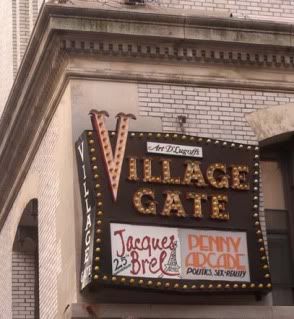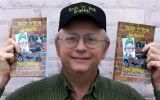
Upper Peninsula native Lodi Carr
and current resident Bill Carrothers
both performed at New York City's Village
Gate during the 1990s. The famous jazz
venue closed in 1993.
By STEVE SEYMOUR
The metropolitan world of jazz and the isolated Upper Peninsula have an improbable relationship.
As evidence, consider the fact that the U. P. spawned the career of jazz singer Lodi Carr and currently provides sanctuary for jazz pianist Bill Carrothers.
Both performers have dazzled crowds at the Village Gate, a famed jazz club at the corner of Thompson and Bleecker Streets in New York City's Greenwich Village.
Born in Marquette, Carr's parents and older brother were amateur singers. She sang in church as a youngster.
Moving to Detroit, she attended jam sessions while still in high school and first sang with Milt Jackson in the late 1940s.
Carr began to sit in with a trio led by Otis "Boo" Turner at the West End Hotel. She moved to New York with Turner in the mid-50s, working in New Jersey and at the Continental in Brooklyn.
During the 1950s, she earned a solo gig at a jazz club called Page Three.
Still, she went back to Detroit for a time in 1958, returning to NYC in the summer of the following year.
Although Carr has had many career highlights, she is probably best known for her first LP, "Lady Bird," released in 1960.
Lodi Carr
The album's attractive color cover pictures the young singer perched in a tree, apparently an attempt to illustrate the album's title.
The photograph was taken by George Jones, while the cover was designed by Walter Rich.
Influential jazz critic Nat Hentoff lauded Carr's talents in liner notes printed on the back cover.
The 11-track long-player was produced by Murray Singer.
"Lady Bird," the album's title track, opens side 2. The song was composed by Tadd Damerson, with lyrics contributed by Otis "Boo" Turner.
A second original song, "Tumble-In-Down," composed by Robert Mellin, with lyrics by Stan Free, is found on side 1.
In fact, the Stan Free Sextet backed Carr on some of the cuts, while the Jerry Segal Trio appeared on other selections.
A 45 rpm single, "If I Should Lose You," coupled with "When I Fall In Love," was issued to promote the album.
Carr was one of the first signings to Laurie Records, formed in March, 1958 by brothers Bob and Gene Schwartz, Elliot Greenberg and Allan I. Sussel.
Now owned by EMI- Capitol Special Markets, Laurie's stable of artists included Dion & the Belmonts, Gerry & the Pacemakers and the Royal Guardsmen.
Carr's debut album effectively launched the Upper Peninsula native beyond her Detroit base.
She met her husband in 1960 and had a son, Joseph, the following year, putting her career on hold for her family. Carr returned to jazz in 1982.
From 1986 to 1992, she performed weekly at the Village Gate. The venue, which hosted many of her early appearances, closed in 1993.
Now 75, Carr continues to reside in New York.
While Carr is an Upper Peninsula native, 45-year-old Carrothers moved here after launching a successful cosmopolitan jazz career.
Bill Carrothers
A professional pianist for more than 25 years, Carrothers has played many venues throughout the United States and Europe.
Rather than a big city existence, Carrothers has chosen to live in Mass City, a tiny community in the U. P.'s Ontonagon County.
An old copper mining town, Mass City features a general store, two restaurants, two bars, acres of wilderness and solitude.
The rural area offers Carrothers the quiet he needs for composing and boundless acres for one of his favorite past-times-- snowmobiling.
Carrothers has an impressive catalog of 16 recordings as a band leader, all critically acclaimed.
His albums appear on such labels as Birdology, Sketch, Illusions and Pirouet. He also distributes compact discs via his own Bridge Boy Music.
Carrothers performed with his trio, including bassist Nic Thys and drummer Dre Pallemaerts, at Village Vanguard during a week of shows in July.
The program was reviewed by music critic Nate Chinen in the New York Times.
Carrothers had made a move away from the New York clubs and his last week-long engagement came at the Village Gate, Carr's home base, back in 1990.
Opened by Art D'Lugoff in 1958, the Village Gate is where Aretha Franklin made her first New York appearance and where Bob Dylan wrote "A Hard Rain's A-Gonna Fall."
Recent albums by Carrothers have included 2006's "Shine Ball" and "Home Row," from 2008.
A history enthusiast, Carrothers has also turned out CD's such as "Armistice 1918" and "Civil War Diaries."
Carrothers first found himself in northern Michigan on a snowmobiling trip. He fell in love with the U. P. and the exhilaration of snowmobiling.
"There are only a few more purely joyful experiences than skimming across a frozen field or twisting through the woods on a sled," Carrothers is quoted as saying.
He and his wife located a home for sale on the Internet and moved to Mass City.
The pair are raising their children in the rural setting and Carrothers keeps his many fans updated on his activities at his website, carrothers.com.
Now, Carrothers performs jazz piano at gigs around the world, then returns to his home in the scenic, sparsely- populated Copper Country, once the center of Finnish culture in the U. P.
The careers of Bill Carrothers and Lodi Carr perfectly illustrate an unlikely relationship between the sophisticated jazz of New York City and the homespun ways of the Upper Peninsula.


 I've enjoyed rock music and writing since I was a teenager in the 60s. I feel lucky to have been around when rock's greatest stars created their most enduring hits. At the same time I found I enjoyed writing, as well. I worked on my high school newspaper and magazine, was editor of several college publications and earned a bachelor's degree from Central Michigan University in 1973. I worked for the daily newspaper in my hometown after graduating, becoming managing editor after a few years. By the 1980s, I moved into public relations. In 1985, my wife Sue and I opened a retail music store, The Record Rack, which we still own. Rock 'n' roll has been integral to me and for the last 2O years I've been earning my living from it even though I don't have a musical bone in my body. In recent years, I've also I edited a small local magazine and launched a micro FM radio station. Now, I'm finally combining my love of writing and rock 'n' roll. I can't sing a note, but I know what I like. I'll tell you all about it when you read on. I hope you have as much enjoyment reading these installments as I've had writing them.
I've enjoyed rock music and writing since I was a teenager in the 60s. I feel lucky to have been around when rock's greatest stars created their most enduring hits. At the same time I found I enjoyed writing, as well. I worked on my high school newspaper and magazine, was editor of several college publications and earned a bachelor's degree from Central Michigan University in 1973. I worked for the daily newspaper in my hometown after graduating, becoming managing editor after a few years. By the 1980s, I moved into public relations. In 1985, my wife Sue and I opened a retail music store, The Record Rack, which we still own. Rock 'n' roll has been integral to me and for the last 2O years I've been earning my living from it even though I don't have a musical bone in my body. In recent years, I've also I edited a small local magazine and launched a micro FM radio station. Now, I'm finally combining my love of writing and rock 'n' roll. I can't sing a note, but I know what I like. I'll tell you all about it when you read on. I hope you have as much enjoyment reading these installments as I've had writing them.


No comments:
Post a Comment